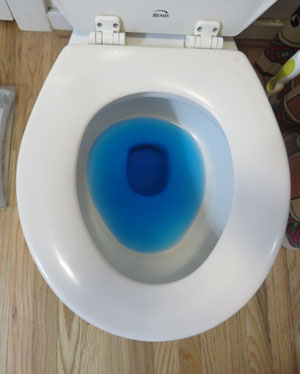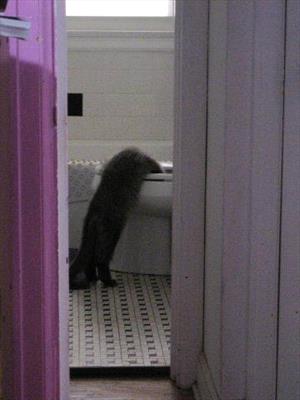toilet with blue water

Photo by VIN
“Don’t let the cat drink the blue toilet water” was a statement that some may remember from their childhood, if that childhood was more than 30-35 years ago. Back then it was true: the dyes used in many toilet bowl drop-in products were quite toxic, not only to cats, but to dogs and people as well. This wasn’t unique because back in the day, many household products were quite hazardous: pine oil-based cleaners could rot your liver, household bleaches could cause serious respiratory and oral damage, and toilet bowl drop-in products contained toxic dyes that could damage red blood cells. Poisonings of humans, mostly children, by common household cleaners resulted in legislation limiting the types and amounts of toxic products that could be in many of these cleaners. Our pets benefit as well from these less toxic compounds.
So today, our pine cleaner still smells perfectly piney without the high concentrations of pine oil, our household bleaches are much more dilute, and toilet bowl drop-in products (tablets, cakes) make pretty blue water that poses no harm to anyone’s red blood cells. That is not to imply that these compounds are innocuous, or that all household products have been rendered less toxic, as automatic dishwashing detergents, laundry detergents, drain openers, oven cleaners and fabric softeners all pose significant hazards to humans and pets if ingested.
What it does mean is the repercussions of the cat or dog taking a slurp out of the toilet, or a lap out of that bucket of mop water with diluted floor cleaner, are much less severe than in the past.
If that’s the case, then why does the product labelling say that you should contact a poison control center if anyone ingests it? Because that’s a pretty standard warning on most household product labels (really, check the labels) since these products were designed to clean toilets and floors, not gastrointestinal tracts.
What might happen if the dog or cat were to indulge in sipping the pretty blue toilet water? Well, they’re basically going to ingest the equivalent of some mildly soapy water, and that might cause some stomach upset (nausea, vomiting); in a worst-case scenario, with a very large ingestion you might also see some diarrhea, although that’s pretty rare. Pets with cast-iron stomachs might not even burp, while those with more touchy tummies may have some pretty good vomiting.
To try to avoid gastrointestinal upset, the ASPCA Poison Control Center recommends giving your blue-bowl drinking pet a bit of some milk or fresh water to further dilute the toilet water. If vomiting occurs, don’t let the pet eat or drink anything for two hours to allow the stomach an opportunity to rest (dogs, especially, like to run to the water bowl after vomiting and refill their stomach, which just results in a vicious cycle of vomiting and drinking). Reintroduce water first and take it away if they start to guzzle; then when they’ve held water down for more than an hour, they can be put back on their normal food and water routine.
 Although the blue water from the toilet bowl isn’t a huge issue, should the pet ingest or lick the tablet itself we could see chemical burns in the mouth and throat from the alkaline corrosive compounds in the concentrated tablet. Licking, chewing or ingesting toilet drop-in tablets or cakes would constitute an emergency and should trigger a trip to the veterinarian after giving some milk or water to try to wash any residual tablet material down into the stomach, where the mucus lining offers some protection. The burns that occur from alkaline corrosives can take several hours to develop (sort of like a sunburn where you get sun exposure in the afternoon, but the full burn doesn’t show up till later that evening), so just because the pet appears fine immediately after exposure doesn’t mean that bad things won’t develop later on.
Although the blue water from the toilet bowl isn’t a huge issue, should the pet ingest or lick the tablet itself we could see chemical burns in the mouth and throat from the alkaline corrosive compounds in the concentrated tablet. Licking, chewing or ingesting toilet drop-in tablets or cakes would constitute an emergency and should trigger a trip to the veterinarian after giving some milk or water to try to wash any residual tablet material down into the stomach, where the mucus lining offers some protection. The burns that occur from alkaline corrosives can take several hours to develop (sort of like a sunburn where you get sun exposure in the afternoon, but the full burn doesn’t show up till later that evening), so just because the pet appears fine immediately after exposure doesn’t mean that bad things won’t develop later on.
So while there are good reasons to discourage your pet from drinking the blue toilet water (one, they might puke; two, even clean toilets may harbor harmful bacteria, and three, eew!), if it should happen, it’s not likely to be a serious problem. While your pet may not mind the pretty blue water, your plumber probably does. A television show asked plumbers what their customers' biggest mistakes are, and one of them, as you guessed, is use of those dissolved tablets: "Ditch the drop-in tank toilet fresheners. You may love the blue water it makes in your toilet bowl, but these tablets often contain chemicals that wear out working parts inside the tank,” the plumber explained. “Plus, as these tablets disintegrate, they can get stuck in the flush valve and prevent the toilet from flushing."
Sure, we all worry more about our pets' health than the plumbing, but corroded plumbing pipes are not a fun way to spend your hard-earned money. Use that money to go on vacation with your pet!
1 Comment
gen6tex
May 25, 2019